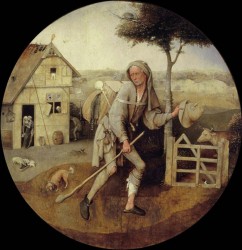
Glück 1904
“Zu einem Bilde von Hieronymus Bosch in der Figdorschen Sammlung in Wien” (Gustav Glück) 1904
[in: Jahrbuch der königlichen Preuszischen Kunstsammlungen, XXV (1904), pp. 174-184]
[Also mentioned in Gibson 1983: 121 (E277)]
In this article Glück attributes an early-Netherlandish tondo from the Vienna Figdor Collection to Bosch because of stylistic reasons. In doing so Glück introduced the Pedlar tondo (today in Rotterdam, Museum Boijmans Van Beuningen) to the modern literature about Bosch. Glück is the first to recognize Bosch as the painter of the panel, an attribution that after him would never be rejected. Glücks iconographical interpretation of the painting is more problematical, though. According to him the protagonist of the tondo is the Prodigal Son at the moment of his spiritual reform: he has left the evil inn behind and is now heading for his father. Already in the first paragraphs of his article Glück emphasizes that the most important motifs of the well-known parable are humility and repentence (Erniedriging und Reue). Bosch turned the depiction of the biblical story into a popular genre painting (ein Sittenbild, ein Volksstück).
Glück views the tondo as a representation of the Prodigal Son parable because of four (rather unconvincing) reasons. The evil inn (and more precisely the Bauernfrau [peasant woman] in the doorway who is approached by a Bursche [tough guy] with erotic intentions) is said to refer to the Prodigal Son’s licentious way of life. The pigs that are eating from a manger a bit further on, are the pigs that were tended by the Prodigal Son. Moreover the protagonist is wearing beggar’s rags and is holding a shepherd’s crook in his right hand. The combination of these three arguments implies that the so-called Prodigal Son is herding pigs in the same inn from which he had been expelled after his excesses, which does not correspond with the biblical text. Glück tries to circumvent this implied contradiction by associating the complete inn with an agrarian atmosphere: the inn is a Bauernherberge (a country inn), the woman in the doorway is a Bauernfrau (peasant woman), an alte Bäuerin (old farmer’s wife) is looking out the window and round the corner a Bauer (farmer) is relieving nature. Furthermore the stick which is being held by the protagonist, is definitely not a shepherd’s crook.
Glücks fourth argument does not make his interpretation more convincing. Glück signals that the old inventories of Philip II mention still another parable that was painted by Bosch: the parable of the blind men (which we only know through a copper engraving by Peter van der Heyden). That Bosch (possibly) painted a parable can hardly be seen as a reliable argument to recognize the depiction of a parable in any other given work of the same painter. Moreover Glück’s iconographical description of the tondo is not without errors. He identifies the bird which is dangling from a branch above the protagonist as a woodpecker, but it is actually a great tit. Not identifying the protagonist himself as a pedlar is a crucial omission that was bound to lead to a wrong interpretation in 1904.
Another methodological flaw is the fact that Glück describes and interprets the tondo without taking into account the closed wings of the Haywain triptych, whereas by means of their central motif (a pedlar is being attacked by an aggressive dog) these two paintings clearly refer to each other. Furthermore it is a risky business to limit the interpretation of a late-medieval panel to a few details, leaving the major part of the painting untouched and unexplained. If all these objections are put together, this can only lead to one objective conclusion: Glück’s skills as an art historian and more precisely as an author on Bosch were more apparent in the field of stylistics (he was indeed the first to recognize the hand of Bosch in this painting) than of iconography. This severe opinion about Glück 1904 can also be found in Marijnissen 1987: 410, where it is said that because of Glücks misconception the Rotterdam tondo deserves an unofficial nickname: The Misunderstanding. Of course one should take into account that in 1904 a sophisticated iconographical-iconological method did not yet exist.
As for the catalogue of authentic Bosch paintings Glück agrees with Justi, not with Dollmayr. According to Glück the Vienna Last Judgement triptych is a faithful smaller copy of a Bosch original. The two saints on the closed wings (Saint James the Elder and Saint Bavo) signal that Philip the Fair could be the patron. That Philip the Fair once ordered a Last Judgement triptych with Bosch is proven by an archival document [p. 181 (note 2)].
[explicit]